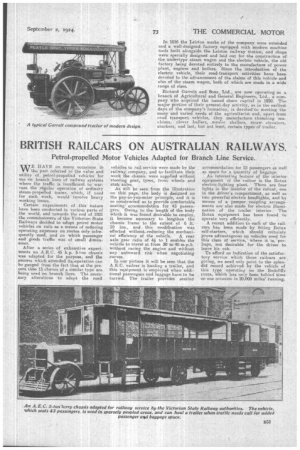BRITISH RAILCARS ON AUSTRALIAN RAILWAYS.
Page 13

If you've noticed an error in this article please click here to report it so we can fix it.
Petrol-propelled Motor Vehicles Adapted for Branch Line Service.
WE BAVE on many occasions in the past referred to the value and ntility of petrol-propelled -vehicles for use on branch lines of railway systems where the traffic is insufficient to warrant the regular operation of ordinary steam-propelled trains, which, if used for such work, would • involve heavy working losses.
Certain experiments of this nature have been conducted in various parts of the world, and towards the end of 1921 the commissioners of the Victorian State Railways decided to adopt petrol motor vehicles on rails as a means of reducing operating expenses on routes only infrequently used, and on which passenger and goods traffic was of small dimensions.
After a series of exhaustive experiments an A.R.C. 45 h.p. 5-ton chassis was adapted for the purpose, and the success which attended its ..operationcan be gauged from the fact that at the pre. sent time 13 chassis of a similar type are being used on branch lines. The necessary alterations to adapt the road vehicles to rail service were made by the railway cornpany, and to-facilitate their work the Chassis were supplied without steering gear, tyres, front wheels and stub axles.
As will be seen from the illustration on this page, the body is designed on the pay-as-you-enter principle, and it is so constructed as to provide comfortable seating accommodation for 43 passen. gers. Owing to the length of the body Which it was found desirable to employ, it became necessary to lengthen the chassis frame to the extent of 6 ft. 10 ins., and this modification was effected without reducing the mechani
cal efficiency of the vehicle. A rear axle gear ratio of 41 to 1 enables the vehicle to travel at from 30 to 40 m.p.h. without racing the engine and without any untoward risk when negotiating curves.
In our picture it will he seen that the A.E.C. railcar is hauling a trailer, and this equipment is employed when additional passengers and luggage have to he carried. The trailer provides seating
accommodation for 12 passengers al; well as space for .a quantity of baggage, ...4n interesting feature of the interior equipment of the railcar is the Rotax electric-lighting plant, There are four not, in the interior of the railcar, one in the driver's compartment, as well as two powerful electric headlights, and by means of a jumper coupling arrangements are also made for electric illumination of the trailer interior. The Rotax equipment has been found to
operate very efficiently. .
A recent addition to each of the railcars has been made by fitting Relax self-starters, which should certainly prove advantageous op vehicles used for this class of service, where it is, perhaps, not desirable fur the -driver to leave his cab.
To afford an indication of the satisfactory service which these railcars are giving, we need only point to the splendid record achieved by the vehicle of this type operating on the Redcliffs route, which has only been behind time on one occasion in 20,000 miles' running.






























